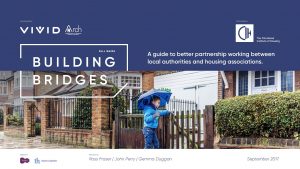If you work for a local authority or housing association, does it know whether its rents are affordable to those on low incomes, and if so how has it worked this out? Does it do its own assessment, or just rely on government guidelines? How will this change in future and what are the implications for new build rents and even for the rents charged when reletting current stock?
These are the questions social landlords should have answers to. But the work we’ve done for Building Bridges – A guide to better partnership working between local authorities and housing associations suggests if some social landlords have answers, it’s not usually on the basis of systematic research. Fewer still are part of an agreed affordability framework covering all social landlords in an area, whether it’s one local authority, a sub-region or a wider housing market area.
Why is such a framework important? At national level the government has been criticised for putting too much emphasis on increasing overall housing supply, without ensuring enough homes are built for those who can’t pay market prices (to buy or to rent). The same applies locally. If developers are mainly providing expensive, three of four-bedroom houses, and not enough smaller homes or ones for sale or rent at affordable prices, they aren’t helping as much as they could to tackle needs. If housing associations are building only to let at Affordable Rent or to sell for shared ownership, are they catering for those in low-paid work? Are landlords assuming that affordability issues are dealt with via the benefits system, when this assumption is increasingly untrue? Will they get their product mix and pricing right, without detailed knowledge of their customers’ ability to pay?
Talking to housing associations and local authorities while developing the Building Bridges guide, we were surprised both at how often affordability issues were raised but also at how few landlords are tackling the fundamental problem of high housing costs. Yes, work is being done to sustain tenancies, get people into jobs and assist tenants with benefit claims, but often rental policy is decided mainly by reference to government rules, without local affordability being seen as a critical factor.
There are exceptions. Family Mosaic (now part of Peabody) assessed the affordability of Affordable Rents when they were first introduced, and decided to set them close to the level of social rents, to keep them within the means of most tenants. Riverside have tested rent levels against the national living wage. Some local authorities, including Blaby and Charnwood in Leicestershire, have done assessments of the proportion of people who could pay an Affordable Rent. Oxfordshire County Council assesses how many people need affordable housing as part of its strategic housing market assessment.
But these examples, though inspiring, fall short of providing a full local housing affordability framework. What should an LHAF look like? The aim is to build a profile of household incomes in the area, especially of those groups most in housing need, compare these with the rents and prices of affordable housing available or planned, taking account of the availability of benefits, and recommend the ideal mix of products and costs to meet these needs (subject, inevitably, to resource availability). Put like this, such an assessment might sound straightforward but identifying target household groups and collecting good quality income data on them may require survey work as well as interrogating statistics that are already available. The guide outlines some approaches, possible snags, and how the LHAF should feed into decision-making.
Why do it? First, in a housing crisis, generated as much by people’s struggle to meet market prices as much as by the sheer shortage of homes, if we only address the supply problem we are in danger of leaving many people without housing they can afford. Second, factors such as slow wage growth, different employment patterns and changes in benefits affect not only tenants and potential tenants but also landlords’ incomes. Third, landlords need to get their offer right, and to do this they need to know how much tenants can pay without stretching household budgets. And fourth, if all social landlords subscribe to a local framework, including an agreed level of flexibility to raise rents over time, they won’t undercut each other and they’ll make more efficient use of their own resources.
There are many more reasons for developing LHAFs, set out in the guide. We hope not only to stimulate more local frameworks, funded jointly by social landlords and bolstered by a commitment to abide by the outcomes, but also that government will come on board and realise that LHAFs are vital in assessing real local need for affordable housing. Even better, they would put some funding into the development of detailed guidance for councils and housing associations to use, and encourage their adoption in every local authority area.
Find out more about the Building Bridges and download a copy of the summary report or the full report here.
Original article: Chartered Institute of Houisng.


 John Perry lives in Masaya, Nicaragua where he works on
John Perry lives in Masaya, Nicaragua where he works on